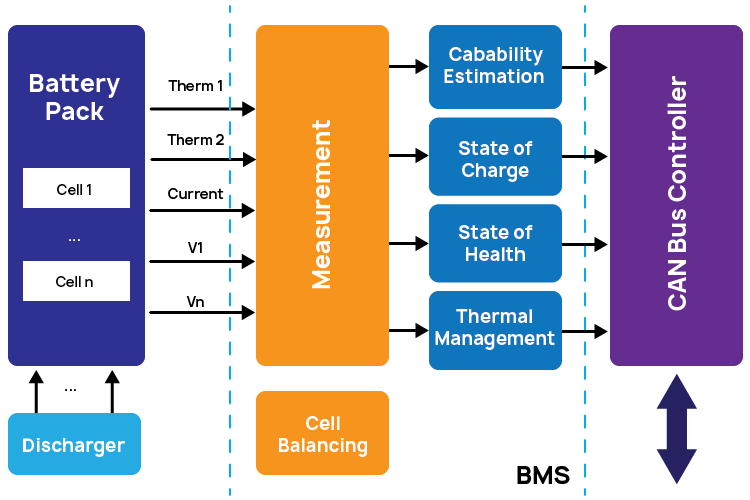
ACL Digital
5 Minutes read
High-Voltage Batteries for Smart Energy & Sustainability
Electrification is reshaping how industries operate, sparking an unprecedented demand for energy-dense, high-performance batteries. From electric vehicles (EVs) and industrial automation to grid modernization and renewable energy integration, high-voltage batteries are at the core of this transformation.
Estimates for the high-voltage battery market in 2030 vary across research firms, reflecting strong growth driven by electric vehicle (EV) adoption and renewable energy storage demands. Precedence Research projects the market to reach USD 174.8 billion by 2030, growing at a CAGR of 36.68% from 2022 to 2030.
Acumen Research and Consulting anticipates a significantly higher market size of USD 550.4 billion by 2032, with a CAGR of 38.7% from 2023 to 2032. Stratistics MRC forecasts the market will grow from USD 58.5 billion in 2024 to USD 385.6 billion by 2030, at a CAGR of 36.9%. According to the International Energy Agency (IEA), battery demand for energy storage is expected to increase 15-fold by 2030, with high-voltage batteries playing a critical role in powering both grid-scale applications and electric mobility solutions.
As global markets shift toward sustainable, low-carbon operations, understanding the nuances of high-voltage battery technology, its chemistry, performance parameters, safety concerns, and real-world applications becomes essential. This blog explores the evolving high-voltage battery landscape and how engineering innovation is enabling its rapid growth.
What are the Types of High-Voltage Batteries?
Understanding the underlying chemistry is key to selecting the right battery for the application, considering energy requirements, safety, and cost. Each chemical combination has its trade-offs and professionals need to weigh them up to match the battery to the use case.Battery chemistry defines the performance, safety, and longevity of high-voltage systems. Here’s a breakdown of leading types:
Lithium-Ion (Li-ion)
- Use Case: EVs, consumer electronics
- Benefits: High energy density, compact size, fast charging
Lithium Iron Phosphate (LiFePO4 / LFP)
- Use Case: Backup power, EVs prioritizing safety, Military, Electronic machines
- Benefits: Longer life cycle, high thermal stability, High safety, Low weight to density ratio
Lithium High Voltage (LiHV)
- Use Case: Next-gen energy systems like UAVs and drones
- Benefits: Higher voltage thresholds, increased capacity for advanced applications
What is SoH, SoC & BMS?
Understanding and managing the core parameters of battery performance is crucial for system longevity and safety.
State of Health (SoH)
- Reflects a battery’s current condition versus its original capacity.
- Vital for lifecycle planning, maintenance schedules, and cost optimization.
State of Charge (SoC)
- Indicates real-time charge levels.
- Accurate SoC monitoring prevents degradation and improves battery efficiency.
Battery Management Systems (BMS)
- Acts as the battery’s brain, ensuring safe and optimal operation.
BMS Core Functions
- Monitors battery’s voltage, current, temperature
- SoH/SoC monitoring
- Cell balancing
- Thermal regulation
- Overcharge, over-discharging and short-circuit protection
How Does a Battery Management System (BMS) Work?
A Battery Management System (BMS) functions as the brain of a battery pack. It is connected to multiple sensors that continuously monitor each battery cell’s voltage, current, and temperature. This real-time data is analyzed by the BMS to ensure every cell operates within safe and defined limits.
If the system detects any deviation, it takes corrective actions. For instance, if the battery pack overheats, the BMS activates the cooling system to bring the temperature down. If cell voltages become unbalanced, it redistributes energy among the cells to ensure uniform voltage levels across all cells.
In addition to managing temperature and voltage, the BMS also tracks data to assess the battery’s state of charge (SOC) and overall health, helping extend the battery’s performance and lifespan.

Key Challenges in High-Voltage Battery Systems & Solutions
| Challenge | Engineering Solution |
| Thermal management of high-density cells | CFD modeling and thermal simulations for optimized cooling |
| Real-time battery diagnostics | Edge-to-cloud platforms for data logging, alerts, and analytics |
| BMS firmware complexity | Custom embedded firmware with OTA updates and cybersecurity |
| Cell balancing across large packs | AI-powered algorithms for precision charge/discharge regulation |
Industrial Applications & Use Cases of High-voltage Batteries
High- voltage batteries are unlocking new levels of performance and efficiency across a range of industries:
Automotive
Electric vehicles (EVs) are at the forefront of high-voltage battery applications, with regions like Europe, China, and North America leading the charge through favorable policies, robust infrastructure, and rising demand for sustainable transport. From compact cars to heavy-duty trucks, the automotive sector depends on custom Li-ion battery packs that deliver high energy density and extended range. Key applications include passenger EVs and hybrids, battery swap stations for two- and three-wheelers, electric buses in public transport systems, and heavy-duty vehicles used in construction, all contributing to the global shift toward cleaner mobility solutions
Industrial Equipment
Industrial environments demand robust and reliable power solutions, making high-voltage batteries essential for maintaining uninterrupted operations. These batteries are vital in ensuring consistent performance across applications such as forklifts and material handling equipment in warehouses, high-capacity power systems for trains and escalators, and dependable energy support for large-scale servers and data centers where operational continuity is critical.
Renewable Energy
Renewable energy sources like solar and wind are naturally intermittent, making energy storage crucial for stability and efficiency. High-voltage batteries help bridge the gap by storing excess energy during peak production and releasing it when generation drops, as demonstrated in large-scale systems like Tesla’s Hornsdale Power Reserve. These batteries play a key role in stabilizing grid output and supporting efficient energy use. Lithium-ion battery suppliers are continuously innovating to meet the unique demands of renewable energy applications, such as residential and commercial solar storage, grid-scale peak load management, and hybrid systems that integrate solar, wind, and battery storage for optimal performance.
Smart Agriculture
Modern agriculture increasingly relies on technology to boost productivity and sustainability, and high-voltage batteries are at the core of this transformation. They power innovations like electric tractors, autonomous harvesters, and precision farming drones—helping address labor shortages and reduce environmental impact. From eco-friendly field equipment to battery-powered irrigation and renewable energy storage for off-grid farms, high-voltage batteries enable smarter, greener agricultural practices.
Electric Vehicles (EVs)
The fundamental component of electric vehicles are high-voltage batteries that offer the energy density needed for long-distance driving and facilitate quick charging times. As automakers innovate for better range and efficiency, these batteries are also becoming lighter and more compact. The demand for high-voltage batteries in the automotive sector continues to grow as the world pushes toward electric vehicles and zero-emission goals.
Grid Stabilization
High-voltage batteries are utilized for grid stabilization, storing excess energy and releasing it during periods of high demand, preventing blackouts, and balancing supply and demand. They are essential in supporting renewable energy integration, enabling utilities to respond quickly to fluctuations in power generation and consumption, and maintaining consistent energy delivery.
Aerospace and Defense
High-voltage batteries power systems in satellites, uncrewed aerial vehicles (UAVs), and military vehicles, where high energy density and power output are crucial. In these mission-critical environments, reliability, compact form factor, and the ability to withstand extreme temperatures and vibrations are essential. Advanced battery systems also support longer flight durations and increased payload capacities in UAVs, enhancing tactical and surveillance capabilities.
Conclusion
High-voltage batteries are not just power sources—they are enablers of progress. Their role in shaping sustainable mobility, reliable grid systems, and eco-friendly farming is undeniable.
At ACL Digital, we bring together Product, Digital, and Quality Engineering to help clients:
- Design develop high-performance solutions
- Integrate smart IoT solutions
- Validate safety, reliability, and compliance
We deliver embedded, cloud and hardware engineering services that enable seamless integration to the solution, industrial, and off-grid systems.




